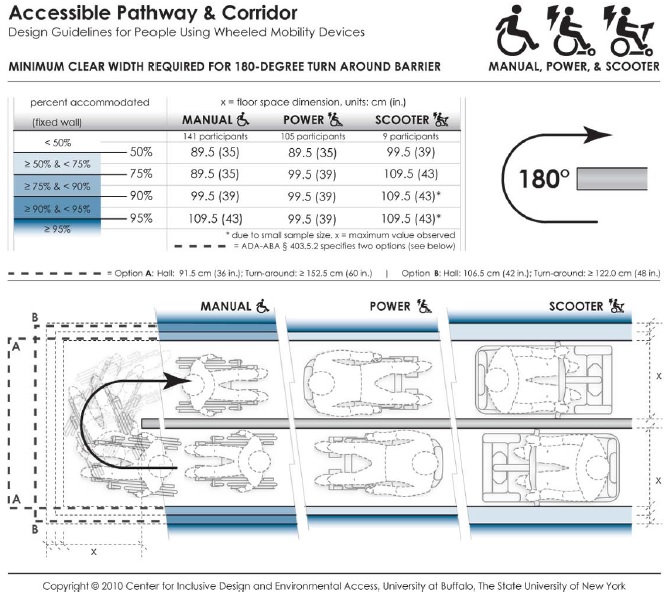4.3.5.3 180-degree turn around an obstacle
This type of turn is applicable to turning at a landing where one is reversing direction to move back along a parallel path, e.g. at the end aisles in library stacks or supermarkets, at switchback ramps or in a terminal queue. The current ADA-ABA standard for the space needed to complete maneuver is based on the width of the entry aisle and the width of the intervening obstacle, e.g. shelving. In our research, we studied the impact of keeping the depth of the turning area and the entry/egress aisle width identical. This provided the opportunity to discover if a wider aisle would lead to less required depth in the turning area. This was, in fact, the case. The accommodation model depicts the results with the condition that depth is the same as access and egress aisle width. We found that a width of 1065 mm (42 in.) for all three dimensions would accommodate more than 90% of the manual wheelchair and more than 95% of the power chair users but less than 80% of the scooter users. We recommend using this approach in future ADA-ABA standards with a minimum width of 1095 mm (43 in.) which would accommodate more than 95% of all WhMD users in the sample. This would increase the width slightly but reduce the depth of the turning area significantly. When the entry and egress aisles are less than this width, the 360-degree turn clearances should be provided at the turning area. In effect, this condition is a space bounded by three sides and requires a lot more space because WhMD users cannot cut the corner like they can with a wider aisle width (Figure 4‒6).

Figure 4-6: Accommodation model depicting the minimum clear width required by users of manual wheelchairs, powered wheelchairs and scooters to complete a 180-degree turn around an obstacle.
Long Description: This data depicts the amount of space required by users of wheeled mobility devices to perform a 180-degree turn ("U-Turn") around an obstruction. The bold dashed line in the table and figure indicates the current ADA requirements, which vary based on the passage width and space available at the base of the turn. Findings from the Anthropometry of Wheeled Mobility Study indicate that a uniform width of at least 89.5 cm (35 in.) was required for 50% of the manual and power wheelchair users measured in this study to perform a 180-degree turn around the obstruction. A width of 109.5 cm (43 in.) was required in order to accommodate 95% of all users. These data are based on measurements of wheeled mobility users performing 180-degree turns around an obstruction, built with mock walls. An obstruction of 11 cm (4 in.) was fixed at a central location. Three moveable walls were constructed around the central fixed wall to form a U-shaped hallway of equal passage width. The enclosed space was incrementally and uniformly increased until a user could pass through the U-turn successfully. The minimum space required for completing a 180-degree turn around an obstruction within moving or knocking down any of the walls was recorded. Use of multiple short turns was allowed in contrast to a single continuous turn.

User Comments/Questions
Add Comment/Question